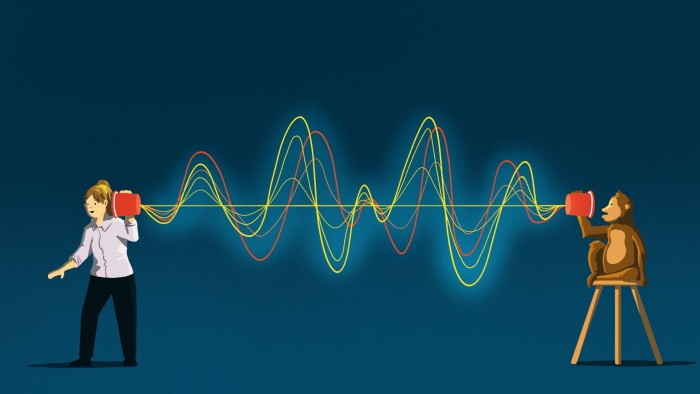If an animal could speak, would we listen?

Stay informed with free updates
Simply sign up to the Science myFT Digest — delivered directly to your inbox.
The writer is a science commentator
Mention Dr Dolittle, and it is impossible not to hum the film’s Oscar-winning ditty written by Leslie Bricusse and sung by Rex Harrison: “Think what it would mean if I could talk to the animals, just imagine it/ Chatting to a chimp in chimpanzee/Imagine talking to a tiger, chatting to a cheetah/What a neat achievement that would be.”
The famed, fictional naturalist has now inspired a lucrative science prize aimed at cracking the challenge of interspecies communication. Last week, an inaugural $100,000 went to a US team studying dolphin whistles.
A grand prize of a $10mn equity investment, or an alternative of $500,000 cash, awaits whichever research team can truly deliver the goods: not just deciphering the language of another species but using it to elicit a reply from an animal.
The Coller Dolittle challenge — bankrolled by a philanthropic foundation set up by financier Jeremy Coller, a vegan and animal lover who describes the current food system as unsustainable — is unashamedly modelled on the Turing test. That 20th-century test spurred efforts to design a machine capable of imitating human conversation, and became a touchstone in the evolution of AI.
It also became a magnet for concerns about machines duping, even usurping, humans. The ability to commune with other species is likely to raise similar, unsettling questions as research progresses. Is it ethically acceptable for a person to trick an animal into communicating with them?
And if we were able to decode animal chatter, should this knowledge alter how we treat them, whether as pets, labour or food? The prize presents a moral challenge, then, beyond the purely scientific: it compels us to reconsider our relationships with other species.
The winning dolphin research was led by Laela Sayigh and Peter Tyack, of Woods Hole Oceanographic Institution in Massachusetts. Through recording the sounds of a pod of bottlenose dolphins in Florida for decades, they discovered around 20 distinct whistles used for messaging.
That work was up against three other shortlisted entries: a project in Germany to analyse and play back nightingale whistles, allowing researchers to interact with the birds; the discovery by a team in France that cuttlefish gesture to each other using arm movements; and research, by a group in Israel, suggesting that marmoset monkeys have names, using specific vocalisations to identify each other. The scientific judging panel was headed by bat expert Yossi Yovel, of Tel Aviv University.
The philosopher Jonathan Birch, also a judge and director of the Jeremy Coller Centre for Animal Sentience at the LSE, stressed to me that the challenge is looking beyond the interspecies communication we have with pets, or that a farmer has with a sheepdog.
Those relationships involve signalling and behavioural responses, Birch explains, “but that’s not telling us how animals communicate with each other . . . this prize is about understanding it so well that we can start to join the conversation.”
He cites the lack of data as the biggest hurdle, with the shortlisted entries all showing ingenuity in data collection (the rules stipulate it must be non-invasive); he also expects AI to play a starring role in spotting patterns. A $100,000 prize will be awarded every year for the best effort until the grand prize is claimed. Birch declines to speculate which species will give up its secrets first, and when.
The prize rules specify that a winner will be announced when an “animal communicates independently without recognizing that it is communicating with humans”.
It is hard to see how researchers can succeed without deception, though this trickery is bound to raise hackles. Birch welcomes such moral debates; his main concern is the possible misuse of animal communication technology, such as replacing farm workers with AI.
I wonder what our reaction to real-life Dolittlism might be. We could be blown away by bats that are bards, Machiavellian monkeys or philosopher parrots. Alternatively, all that whistling, warbling, whooping and waving might add up to a disappointingly basic syntax of survival.
While Coller hopes his philanthropy will reshape our attitude to animals, the truth is that even revelatory research has largely failed to move the dial on their welfare.
Recent work on cephalopod sentience and intelligence has not stopped plans to farm the creatures. We might one day be able to understand what animals are saying — but there is no guarantee we will listen.








